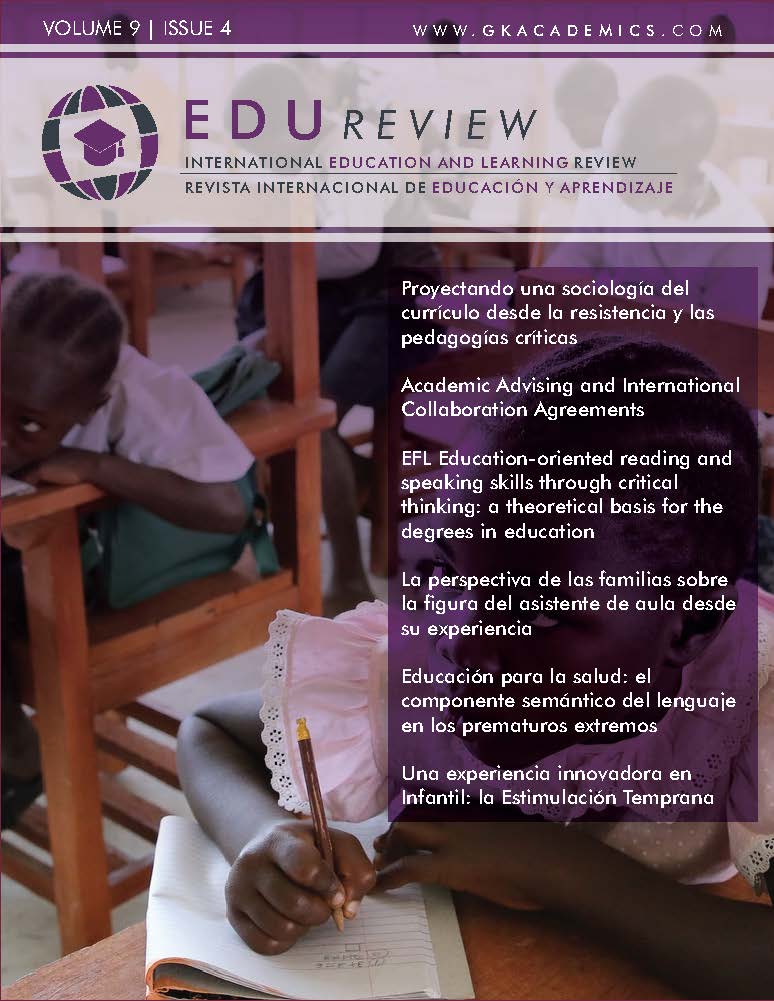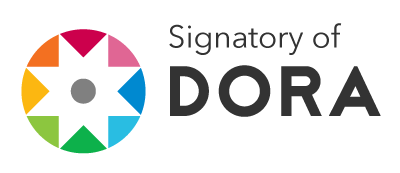Educación para la salud: el componente semántico del lenguaje en los prematuros extremos
DOI:
https://doi.org/10.37467/gkarevedu.v9.3037Palabras clave:
Prematuro, Edad gestacional, Lenguaje, Semántica, Rendimiento escolarResumen
Un nacimiento prematuro se asocia con un mayor riesgo de alteraciones en la competencia lingüística, pudiendo incidir de manera negativa en los procesos de aprendizaje y en el rendimiento escolar. Esta investigación, de carácter prospectivo y longitudinal, identifica la posible relación existente entre la edad gestacional y el componente semántico en 29 prematuros extremos. A todos se les evaluó el lenguaje mediante BLOC-SR en el Hospital Universitario La Paz (Madrid). Los resultados evidencian una correlación significativa entre ambas variables, interfiriendo en el desempeño académico de estos menores e incrementando su ya desventaja ante el aprendizaje debido a su inmadurez gestacional.
Descargas
Estadísticas globales ℹ️
|
804
Visualizaciones
|
324
Descargas
|
|
1128
Total
|
|
Citas
Acosta, V.M. (2008). Evaluación del lenguaje BLOC-Screening. Revista de Logopedia, Foniatría y Audiología, 28(4), 261–264. https://doi-org.bucm.idm.oclc.org/10.1016/S0214-4603(08)70132-3 DOI: https://doi.org/10.1016/S0214-4603(08)70132-3
Amalric, M., Wang, L., Pica, S., Figueira, S., Sigman, M., & Dehaene, S. (2017). The language of geometry: fast comprehension of geometrical primitives and rules in human adults and preschoolers. PLoS Computational Biology, 13(1), 1–31. https://doi.org/10.1371/journal.pcbi.1005273 DOI: https://doi.org/10.1371/journal.pcbi.1005273
Al Roumi, F., Dotan, D., Yang, T., Wang, L., & Dehaene, S. (2019). Acquisition and processing of an artificial mini-language combining semantic and syntactic elements. Cognition, 185, 49–61. https://doi.org/10.1016/j.cognition.2018.11.006 DOI: https://doi.org/10.1016/j.cognition.2018.11.006
Aylward, G. (2002). Cognitive and neuropsychological outcomes: more than IQ scores. Mental retardation and developmental disabilities research reviews, 8(4), 234–240. https://doi.org/10.1002/mrdd.10043 DOI: https://doi.org/10.1002/mrdd.10043
Barbieri, M. (2020). The semantic theory of language. Biosystems, 190, 104100. https://doi.org/10.1016/j.biosystems.2020.104100 DOI: https://doi.org/10.1016/j.biosystems.2020.104100
Barnes-Davis, M., Williamson, B., Merhar, S., Holland, S., & Kadis, D. (2020). Rewiring the extremely preterm brain: Altered structural connectivity relates to language function. NeuroImage:Clinical, 25, 102194. https://doi.org/10.1016/j.nicl.2020.102194 DOI: https://doi.org/10.1016/j.nicl.2020.102194
Brósch-Fohraheim, N., Fuiko, R., Marschik, P., & Resch, B. (2019). The influence of preterm birth on expressive vocabulary at the age of 36 to 41 months. Medicine, 98(6), e14404. http://dx.doi.org/10.1097/MD.0000000000014404 DOI: https://doi.org/10.1097/MD.0000000000014404
Casado, M.L., Gutiérrez, Á. y Ruiz, J. (2018). Evaluación del desarrollo de un grupo de recién nacidos prematuros frente a niños nacidos a término. Revista Pediatría Atención Primaria, 20(78), 121–131. https://scielo.isciii.es/pdf/pap/v20n78/1139-7632-pap-20-78-121.pdf
Castillo, R.D., Sierra, Y., Inostroza, M., Campos, V., Gómez, E. y Mora, M. (2007). BLOC-Screening en una muestra de niños chilenos. Revista de Logopedia, Foniatría y Audiología, 27(3), 118–125. https://doi-org.bucm.idm.oclc.org/10.1016/S0214-4603(07)70081-5 DOI: https://doi.org/10.1016/S0214-4603(07)70081-5
CEIP Puntagorda (2018, octubre). Importancia de la conciencia fonológica en nuestro alumnado. https://www3.gobiernodecanarias.org/medusa/edublog/ceippuntagorda/2017/10/18/importancia-de-la-conciencia-fonologica-en-nuestro-alumnado/
Chyi, L., Lee, H., Hintz, S., Gould, J., & Sutcliffe, T. (2008). School outcomes of late preterm infants: special needs and challenges for infants born at 32 to 36 weeks gestation. The Journal of Pediatrics, 153(1), 25–31. https://doi.org/10.1016/j.jpeds.2008.01.027 DOI: https://doi.org/10.1016/j.jpeds.2008.01.027
Comunidad de Madrid. (2018). Evaluaciones de educación primaria 2017. Tercer curso, sexto curso, secundaria 2017, cuarto curso. Informe de la Comunidad de Madrid. Resultados y contexto. http://www.madrid.org/bvirtual/BVCM016400.pdf
Comunidad de Madrid. (2017). Evaluación de educación primaria 2016. Tercer curso. Informe Comunidad de Madrid. Resultados y contexto.
Coronado, A., Sáenz-Rico, B., Omeñaca, F. y Díaz, C. (2016). Detección de dificultades comunicativo-lingüísticas en la Educación Secundaria Obligatoria de niños/as nacidos prematuros con un peso menor a 1501. Revista Complutense de Educación, 28(2), 463–477. https://revistas.ucm.es/index.php/RCED/article/view/49474/50231 DOI: https://doi.org/10.5209/rev_RCED.2017.v28.n2.49474
Crespo, N., Alfaro, P. y Góngora, B. (2011). La medición de la sintaxis: evolución de un concepto. ONOMÁZEIN, 24(2), 155–172. http://onomazein.letras.uc.cl/Articulos/24/7_Crespo.pdf DOI: https://doi.org/10.7764/onomazein.24.07
De Kieviet, J., Piek, J., Aarnoudse-Moens, C., & Oosterlaan, J. (2009). Motor development in very preterm and very low-birth-weight children from birth to adolescence: a meta-analysis. JAMA, 302(20), 2235–2242. https://doi.org/10.1001/jama.2009.1708 DOI: https://doi.org/10.1001/jama.2009.1708
Fernández, J.M. y Orta, I. (2011). Dificultades de lectura y escritura: percepción del profesorado ante el alumnado con antecedentes de prematuridad. Revista de Investigación en Educación, 9(1), 84– 101. http://webs.uvigo.es/reined/
Fondo de las Naciones Unidas para la Infancia (UNICEF). (2010). Aprendizaje y escolaridad del niño prematuro. Desafíos para los niños, desafíos para nuestras escuelas. https://www.neurologianeonatal.org/wp-content/uploads/2018/08/APRENDIZAJE_Y_ESCOLARIDAD_NINO_PREMATURO_UNICEF.pdf
Gormley, J. y Williams, D. (2019). Providing supportive hospital environments to promote the language development of infants and children born prematurely: Insights from neuroscience. Journal of Pediatric Health Care, 33(5), 520 – 528. https://doi.org/10.1016/j.pedhc.2019.01.007 DOI: https://doi.org/10.1016/j.pedhc.2019.01.007
Gutiérrez-Cruz, N., Torres-Mohedas, J., Carrasco-Marina, M.L, Olabarrieta-Arnal, I., Martín-Del Valle, F. y García-García, M.L. (2019). Desarrollo psicomotor en prematuros tardíos a los dos años de edad: comparación con recién nacidos a término mediante dos herramientas diferentes. Revista de Neurología, 68(12), 503–509. https://doi.org/10.33588/rn.6812.2018360 DOI: https://doi.org/10.33588/rn.6812.2018360
Institutos Nacionales de Salud (NIH). (s.f.). La comorbilidad. https://www.drugabuse.gov/es/informacion-sobre-drogas/la-comorbilidad
Ivern, I. (2018). Pragmática y desarrollo metalingüístico. Revista Logopedia, Foniatría y Audiología, 38(1), 31–39. https://doi.org/10.1016/j.rlfa.2017.12.003 DOI: https://doi.org/10.1016/j.rlfa.2017.12.003
Kelly, M., & Li, K. (2019). Poverty, Toxic Stress, and Education in children born preterm. Nursing research, 68(4), 275-284. https://doi.org/10.1097/nnr.0000000000000360 DOI: https://doi.org/10.1097/NNR.0000000000000360
Larroque, B., Ancel, P.Y., Marret, S., Marchand, L., André, M., Arnaud, C., Pierrat, V., Rozé, J.C., Messer, J., Thiriez, G., Burguet, A., Picaud, J.C., Bréart, G., & Kaminski, M. (2008). Neurodevelopmental disabilities and special care of 5-year-old children born before 33 weeks of gestation (the EPIPAGE study): a longitudinal cohort study. Lancet, 371(9615), 813–820. https://doi.org/10.1016/s0140-6736(08)60380-3 DOI: https://doi.org/10.1016/S0140-6736(08)60380-3
Lee, E., Yeatman, J., Luna, B., & Feldman, H. (2011). Specific language and reading skills in school-aged children and adolescents are associated with prematurity after controlling for IQ. Neuropsychologia, 49(5), 906–913. https://doi.org/10.1016/j.neuropsychologia.2010.12.038 DOI: https://doi.org/10.1016/j.neuropsychologia.2010.12.038
Ley Orgánica 2/2006, de 3 de mayo, de Educación (LOE). Boletín Oficial del Estado, 106, de 04 de mayo de 2006, páginas 17158-17207. https://www.boe.es/buscar/doc.php?id=BOE-A-2006-7899
Ley Orgánica 8/2013, de 9 de diciembre, para la mejora de la calidad educativa. Boletín Oficial del Estado, 295, de 10 de diciembre de 2013, páginas 1–64. https://www.boe.es/buscar/pdf/2013/BOE-A-2013-12886-consolidado.pdf
Ley Orgánica 3/2020, de 29 de diciembre, por la que se modifica la Ley Orgánica 2/2006, de 3 de mayo, de Educación. Boletín Oficial del Estado, 340, de 30 de diciembre de 2020, 122868 – 122953.
Linsell, L., Johnson, S., Wolke, D., Morris, K., Kurinczuk, J., & Marlow, N. (2019). Trajectories of behavior, attention, social and emotional problems from childhood to early adulthood following extremely preterm birth: a prospective cohort study. European Child & Adolescent Psychiatry, 28(4), 531– 542. https://doi.org/10.1007/s00787-018-1219-8 DOI: https://doi.org/10.1007/s00787-018-1219-8
Marín, M., Sala, L., Moneo, M.I. y Lasarte, J.J. (2020, in Press). Estudio de seguimiento del prematuro tardío en un centro de atención primaria. ¿Cuál es la realidad de esta población? Anales de Pediatría, 95(1), 49-51. https://doi.org/10.1016/j.anpedi.2020.05.018 DOI: https://doi.org/10.1016/j.anpedi.2020.05.018
Marlow, N., Wolke, D., Bracewell, M.A., & Samara, M. (2005). Neurologic and developmental disability at six years of age after extremely preterm birth. New England Journal of Medicine, 352(1), 9–19. https://doi.org/10.1056/nejmoa041367 DOI: https://doi.org/10.1056/NEJMoa041367
Mazzali, S., de Castro, I., Scappini-Junior, W., Nascimiento, M., Ramos, J., Sorares, S., Cristaldo, N.R., Caivano, A., Sucena, B., Rufina, M., Domenico, C., & Vinicius, M. (2021). Methodology for creating and validating object naming and semantic test used by Verst-Maldaun Language Assessment during awake craniotomies. Clinical Neurology and Neurosurgery, 202, 106485. https://doi.org/10.1016/j.clineuro.2021.106485 DOI: https://doi.org/10.1016/j.clineuro.2021.106485
Ment, L., Vohr, B., Allan, W., Katz, K., Schneider, K., Westerveld, M., Duncan, C., & Makuch, R. (2003). Change in cognitive function over time in very low-birth-weight infants. JAMA, 289(6), 705–711. https://doi.org/10.1001/jama.289.6.705 DOI: https://doi.org/10.1001/jama.289.6.705
Ministerio de Educación, Cultura y Deporte (s.f.). Guía para la declaración de nota media de estudios en España. http://cms.ual.es/idc/groups/public/@serv/@uinvestigacion/documents/documento/nota-media-instrucciones.pdf
Monfort, I. (2019). Intervención en pragmática: avances y retos. Revista de Logopedia, Foniatría y Audiología, 39(3), 101–104. https://doi.org/10.1016/j.rlfa.2019.05.001 DOI: https://doi.org/10.1016/j.rlfa.2019.05.001
Van Noort-van der Spek, I., Franken, M.C., & Weisglas-Kuperus, N. (2012). Language functions in preterm-born children: A systematic review and meta-analysis. Pediatrics, 129(4), 745–754. https://pediatrics.aappublications.org/content/pediatrics/129/4/745.full.pdf DOI: https://doi.org/10.1542/peds.2011-1728
Organización Mundial de la Salud (OMS). (2018, 19 de febrero). Nacimientos prematuros. https://www.who.int/es/news-room/fact-sheets/detail/preterm-birth
Organización Internacional de las Naciones Unidas (ONU). (s.f.). ODS 5. Salud y Bienestar. https://www.un.org/sustainabledevelopment/es/health/
Organización Internacional de las Naciones Unidas (ONU). (2015). Resolución aprobada por la Asamblea General el 25 de septiembre de 2015. https://www.agenda2030.gob.es/recursos/docs/APROBACION_AGENDA_2030.pdf
Paquette, N., Vannasing, P., Tremblay, J., Lefebvre, F., Roy, M.S., McKerral, M., Lepore, F., Lassonde, M., & Gallagher, A. (2015). Early electrophysiological markers of atypical language processing in prematurely born infants. Neuropsychologia, 79(A), 21–32. https://doi.org/10.1016/j.neuropsychologia.2015.10.021 DOI: https://doi.org/10.1016/j.neuropsychologia.2015.10.021
Pereira-Cerro, A.V., Lanzarote-Fernández, M.D., Barbancho-Morant, M.M., & Padilla-Muñoz, E.V. (2020). Evolution of psychomotor development in preschool children born prematurely. Anales de Pediatría (English Edition), 93(4), 228–235. https://doi.org/10.1016/j.anpede.2019.10.010 DOI: https://doi.org/10.1016/j.anpede.2019.10.010
Petrou, S., Mehta, Z., Hockley, C., Cook-Mozaffari, P., Henderson, J., & Goldacre, M. (2003). The impact of preterm birth on hospital inpatient admissions and costs during the first 5 years of life. Pediatrics, 112(6), 1290 – 1297. https://doi.org/10.1542/peds.112.6.1290 DOI: https://doi.org/10.1542/peds.112.6.1290
Puyuelo, M., Renom, J. y Solanas, A. (2003). BLOC-Screening y BLOC-Info: aportaciones recientes a la evaluación del lenguaje. Revista de Logopedia, Foniatría y Audiología, 23(4), 195–210. https://www.elsevier.es/es-revista-revista-logopedia-foniatria-audiologia-309-articulo-bloc-screening-bloc-info-aportaciones-recientes-evaluacion-S0214460303757635 DOI: https://doi.org/10.1016/S0214-4603(03)75763-5
Puyuelo, M., Pinsach, R., Solanas, A. y Wiig, E. (2006). Evaluación del lenguaje mediante la batería BLOC. BLOC Screening y BLOC Info. Proceso de diseño, análisis y aplicación. Revista de Logopedia, Foniatría y Audiología, 26(1), 54–61. https://www.elsevier.es/es-revista-revista-logopedia-foniatria-audiologia-309-articulo-evaluacion-del-lenguaje-mediante-bateria-13153259 DOI: https://doi.org/10.1016/S0214-4603(06)70096-1
Puyuelo, M., Renom, J., Solanas, A. y Wig, E. (2007). BLOC-SCREENING-R. Evaluación del lenguaje. Elsevier Masson.
Puyuelo, M., Salavera, C. y Wiig, E. (2013). Aportaciones a la evaluación del lenguaje mediante BLOC-C y BLOC-SR. Revista de Logopedia, Foniatría y Audiología, 33(2), 83–96. https://doi-org.bucm.idm.oclc.org/10.1016/j.rlfa.2013.04.005 DOI: https://doi.org/10.1016/j.rlfa.2013.04.005
Rellán, S., García, C. y Aragón, M.P. (2008). El recién nacido prematuro. https://www.aeped.es/sites/default/files/documentos/8_1.pdf
Resolución de 4 de mayo 2017, de las Viceconsejeras de Educación no Universitaria, Juventud y Deporte y de Organización Educativa, por la que se dictan instrucciones para la celebración de las pruebas correspondientes a la evaluación individualizada de los alumnos de tercer curso de Educación Primaria de la Comunidad de Madrid, en el año académico 2016-2017. Boletín Oficial de la Comunidad de Madrid, 110, de 10 de mayo de 2017, 240 – 247. comunidad.madrid/sites/default/files/doc/educacion/sgea_eval_4eso_2017_bocm-20170510-20.pdf
Ríos-Flórez, J.A. y Cardona-Agudelo, V. (2016). Procesos de aprendizaje en niños de 6 a 10 años de edad con antecedente de nacimiento prematuro. Revista Latinoamericana de Ciencias Sociales, Niñez y Juventud, 14(2), 1071–1085. http://dx.doi.org/10.11600/1692715x.14213241115 DOI: https://doi.org/10.11600/1692715x.14213241115
Rogers, E., & Hintz, S. (2016). Early neurodevelopmental outcomes of extremely preterm infants. Seminars in Prinatology, 40, 497-509. http://dx.doi.org/10.1053/j.semperi.2016.09.002 DOI: https://doi.org/10.1053/j.semperi.2016.09.002
Sansavini, A., Guarini, A. Justice, L.M., Savini, S., Broccoli, S., Alessandroni, R., & Faldella, G. (2010). Does preterm birth increase a child’s risk for language impairment? Early Human Development, 86(12), 765–772. https://doi.org/10.1016/j.earlhumdev.2010.08.014 DOI: https://doi.org/10.1016/j.earlhumdev.2010.08.014
Schnider, B., Disselhoff, V., Held, U., Latal, B., Hagmann, C., & Wehrle, F. (2020). Executive function deficits mediate the association between very preterm birth and behavioral problems at school-age. Early Human Development, 146, 105076. https://doi.org/10.1016/j.earlhumdev.2020.105076 DOI: https://doi.org/10.1016/j.earlhumdev.2020.105076
Stolt, S., Klippo, A., Launonen, K., Munck, P., Lehtonen, L., Lapinleimu, H., & Haataja, L. (2007). Size and composition of the lexicon in prematurely born very-low-birth-weight and full-term finnish children at two years age. Journal child language, 34(2), 283–310. https://doi.org/10.1017/s0305000906007902 DOI: https://doi.org/10.1017/S0305000906007902
Sullivan, M., Lynch, E., & Msall, M. (2020). Late adolescent & young adult functioning and participation outcomes after prematurity. Seminars in Fetal and Neonatal Medicine, 25(3), 101118. https://doi.org/10.1016/j.siny.2020.101118 DOI: https://doi.org/10.1016/j.siny.2020.101118
Taboada, E.V., Iglesias, P.M., López, S. y Rivas, R.M. (2020). Las dificultades neuroevolutivas como categoría comprensiva de las dificultades de aprendizaje en niños con retraso del desarrollo: una revisión sistemática. Anales de Psicología, 36(2), 271–282. https://dx.doi.org/10.6018/analesps.347741 DOI: https://doi.org/10.6018/analesps.347741
Tan, H., Blasco, P., Lewis, T., Ostmo, S., Chiang, M., & Peter, J. (2021). Neurodevelopmental outcomes in preterm infants with retinopathy of prematurity. Survey of Ophthalmology, 6(5), 887-891. https://doi.org/10.1016/j.survophthal.2021.02.012 DOI: https://doi.org/10.1016/j.survophthal.2021.02.012
Tatsuoka, C., McGowan, B., Yamada, T., Andrews, K., Minich, N., & Taylor, G. (2016). Effects of extreme prematurity on numerical skills and executive function in kindergarten children: an application of partially ordered classification modeling. Learning and Individual Differences, 49, 332–340. https://doi.org/10.1016/j.lindif.2016.05.002 DOI: https://doi.org/10.1016/j.lindif.2016.05.002
Tulviste, T., Toome, L., Mannamaa, M., & Varendi, H. (2020). Language skills at corrected age 2;0 are poorer in extremely and very preterm boys but not girls campared with their full-term peers. Early Human Development, 151, 105164. https://doi.org/10.1016/j.earlhumdev.2020.105164 DOI: https://doi.org/10.1016/j.earlhumdev.2020.105164
Taylor, G., Margevicius, S., Schluchter, M., Andreias, L., & Hack, M. (2015). Persisting behavior problems in extremely low birth weight adolescents. Journal of Developmental and Behavioral Pediatrics (JDBP), 36(3), 178–187. https://doi.org/10.1097/dbp.0000000000000139 DOI: https://doi.org/10.1097/DBP.0000000000000139
Zimmerman, E. (2018). Do infants born very premature and who have very low birth weight catch up with their full term peers in their language abilities by early school age? Journal of speech, language, and hearing research, 61(1), 53–65. https://doi.org/10.1044/2017_jslhr-l-16-0150 DOI: https://doi.org/10.1044/2017_JSLHR-L-16-0150
Descargas
Publicado
Cómo citar
Número
Sección
Licencia
Los autores/as que publiquen en esta revista aceptan las siguientes condiciones:
- Los autores/as conservan los derechos de autor.
- Los autores/as ceden a la revista el derecho de la primera publicación. La revista también posee los derechos de edición.
- Todos los contenidos publicados se regulan mediante una Licencia Atribución/Reconocimiento-SinDerivados 4.0 Internacional. Acceda a la versión informativa y texto legal de la licencia. En virtud de ello, se permite a terceros utilizar lo publicado siempre que mencionen la autoría del trabajo y a la primera publicación en esta revista. Si transforma el material, no podrá distribuir el trabajo modificado.
- Los autores/as pueden realizar otros acuerdos contractuales independientes y adicionales para la distribución no exclusiva de la versión del artículo publicado en esta revista (p. ej., incluirlo en un repositorio institucional o publicarlo en un libro) siempre que indiquen claramente que el trabajo se publicó por primera vez en esta revista.
- Se permite y recomienda a los autores/as a publicar su trabajo en Internet (por ejemplo en páginas institucionales o personales), una vez publicado en la revista y citando a la misma ya que puede conducir a intercambios productivos y a una mayor y más rápida difusión del trabajo publicado (vea The Effect of Open Access).













